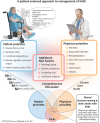Beyond MACE: a multidimensional approach to outcomes in clinical trials for older adults with stable ischemic heart disease
- PMID: 38045910
- PMCID: PMC10690830
- DOI: 10.3389/fcvm.2023.1276370
Beyond MACE: a multidimensional approach to outcomes in clinical trials for older adults with stable ischemic heart disease
Abstract
The global population of older adults is expanding rapidly resulting in a shift towards managing multiple chronic diseases that coexist and may be exacerbated by cardiovascular illness. Stable ischemic heart disease (SIHD) is a predominant contributor to morbidity and mortality in the older adult population. Although results from clinical trials demonstrate that chronological age is a predictor of poor health outcomes, the current management approach remains suboptimal due to insufficient representation of older adults in randomized trials and the inadequate consideration for the interaction between biological aging, concurrent geriatric syndromes, and patient preferences. A shift towards a more patient-centered approach is necessary for appropriately and effectively managing SIHD in the older adult population. In this review, we aim to demonstrate the distinctive needs of older adults who prioritize holistic health outcomes like functional capacity, cognitive abilities, mental health, and quality of life alongside the prevention of major adverse cardiovascular outcomes reported in cardiovascular clinical trials. An individualized, patient-centered approach that involves shared decision-making regarding outcome prioritization is needed when any treatment strategy is being considered. By prioritizing patients and addressing their unique needs for successful aging, we can provide more effective care to a patient population that exhibits the highest cardiovascular risks.
Keywords: acute coronary syndrome; aging; myocardial ischemia; quality of life; survey and questionnaire.
© 2023 Kalra, Moumneh, Nanna and Damluji.
Conflict of interest statement
MN receives consulting fees from Heartflow, Inc, Merck. The remaining authors declare that the research was conducted in the absence of any commercial or financial relationships that could be construed as a potential conflict of interest.
Figures


References
-
- United Nations, Department of Economic and Social Affairs, Population Division. World population prospects 2022 (2022). Online Edition.
-
- Centers for Disease Control and Prevention (CDC). Trends in aging–United States and worldwide. MMWR Morb Mortal Wkly Rep. (2003) 52:101–4, 106. - PubMed
-
- Medina L, Sabo S, Vespa J. Living longer: historical and projected life expectancy in the United States, from 1960 to 2060).
-
- Organization WH. Ageing and health (2022). Available at: https://www.who.int/news-room/fact-sheets/detail/ageing-and-health (Accessed April 15, 2023).
Publication types
Grants and funding
LinkOut - more resources
Full Text Sources

